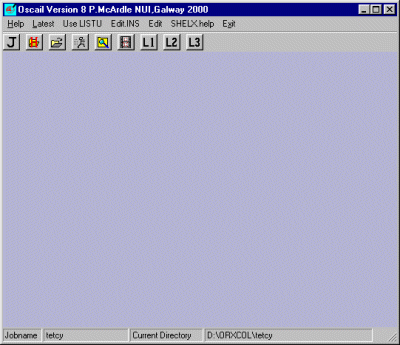
The latest ORTEX (24th February 2000) now has the option to find
voids in a structure. Any Shelx file can be used and it is very user-friendly
operation. If Void finds some voids, it can add these as dummy atoms into
the Shelx file to assist in visualisation.
The following uses the Tetracycline Hydrochloride structure as an example.
|
In the ORTEX directory, run Oscail to bring
up the following starting Window
|
|
Click on the J (Job name) Icon and change the name of
the jobname to tetcy. If not in the \ortex directory
where the tetcy.ins file is located, click on the change directory
icon and enter this directory. (in this case in the \ortex\tetcy directory)
|
|
Click on the Run Job icon and then select Roinn 2
after which the option to run the Void program should be
visible.
|
|
Select Void and run.
When prompted with an options box for Void, going with
the defaults should be OK for this example.
|
|
Void will now present the unit-cell containing the structure.
|
|
While it is possible to examine the structure in more detail
with the various options. We will go straight to the Void
determination which presents the following dialog box.
|
|
We will go with the default. But first it might be wise to
get an estimate of how much time this will take (in this
case on a 166MHz Pentium laptop). Select Calculate
CPU Time then OK. The time will appear at the
top left of the screen.
|
|
As around 5 minutes does not seem that much of a problem,
select Search then OK to start trying to find
some Voids. Any voids found will be indicated on the
screen as it occurs. A % complete bar will indicate how
complete the search is. In the following case, no Voids of
significance are found in the structure.
Void atoms, if found, are given a different colour and there is the option of saving to the Shelx for viewing in other structure evaluation software. |
|
As an example of Void finding voids, following is a Void search
being conducted on a zeolite.
In the result, the blue atoms/balls mark found voids.
Selecting the Reduce menu option will then write a unique set of voids to the Shelx INS file as dummy atoms.
|